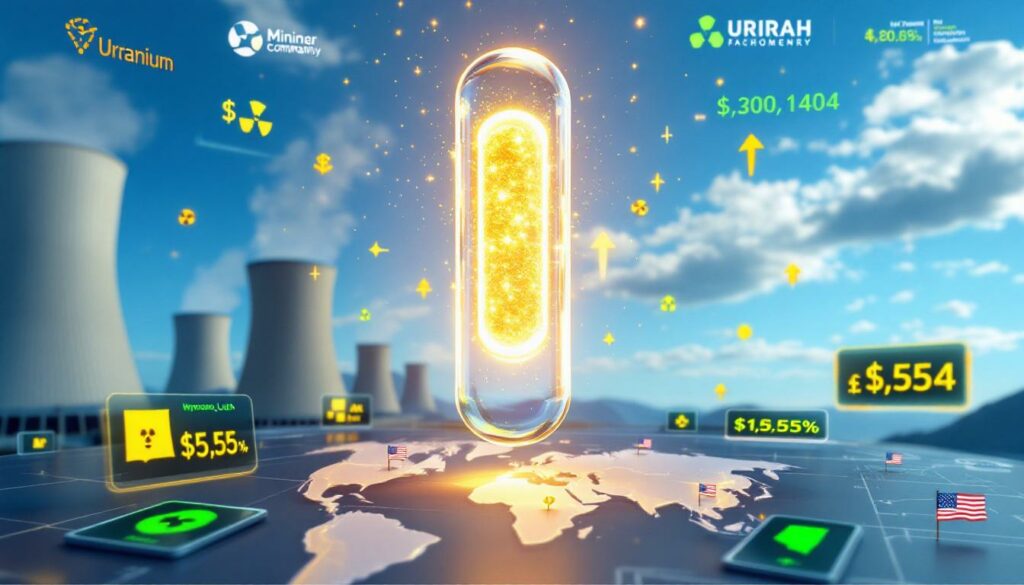What is Driving the Recent Interest in the Uranium Market?
The uranium market has recently displayed renewed vigor after years of stagnation, capturing the attention of institutional investors and market participants alike. Several key developments have created a perfect storm of opportunity that's driving fresh interest in this often overlooked commodity sector.
Physical Uranium Trust's Strategic Moves
The Physical Uranium Trust (SPUT) has emerged as a significant market force, demonstrating the substantial institutional appetite for uranium exposure. Initially seeking to raise $100 million, SPUT quickly secured nearly $200 million in capital, signaling robust institutional confidence in uranium's prospects.
"They picked up $200 million almost immediately, which demonstrates the interest right now in the space," notes Chris Frostad of Pure Point Uranium.
Following this successful capital raise, SPUT's market impact became immediately apparent:
- SPUT deployed this capital to purchase physical uranium on the spot market
- These strategic purchases began tightening the gap between spot and long-term contract prices
- Spot prices responded with an 8-9% increase shortly after these purchasing activities commenced
- The long-term uranium contract price has remained relatively stable at approximately $80/lb
This price stability in long-term contracts amid uranium market volatility highlights the unique structure of uranium markets, where utilities secure fuel through multi-year contracts rather than relying on spot purchases.
Increased Capital Flowing to Advanced Projects
Several advanced uranium development companies have successfully secured substantial funding in recent months, demonstrating growing investor confidence in projects approaching production:
- Bannerman Energy announced an AU$85 million capital raise
- Energy Fuels secured approximately $50 million in recent weeks
- These successful capital raises indicate investor preference for companies with near-term production potential
The ability of these companies to raise significant capital stands in stark contrast to earlier market cycles, when even established names struggled to secure funding. This shift suggests institutional investors now recognize the looming supply deficit in uranium markets.
Merger and Acquisition Activity Accelerating
After nearly two decades of limited M&A activity, the uranium sector is experiencing a notable uptick in consolidation:
- Three significant mergers announced in recent weeks compared to virtually none in the previous 20 years
- Paladin Energy halt and Fission Uranium completed their merger approximately one year ago
- Paladin recently appointed a new CEO with operational experience from Rio Tinto, signaling a shift toward production readiness
- Smaller companies like Nexus Uranium and Basin Uranium have merged to consolidate assets and strengthen their market position
- Premier American Uranium acquired Nuclear Fuels, effectively reassembling former Uranium One assets under experienced management
This consolidation trend suggests industry participants recognize the need for scale and operational expertise as the market transitions from exploration to development and production.
How Are Uranium Equities Performing in the Current Market?
The performance of uranium equities has followed a distinctive pattern that differs significantly from previous market cycles, suggesting an evolution in investor sentiment and market maturity.
Gradual Upward Movement
Unlike the volatile spikes characteristic of previous uranium bull markets, current equity performance demonstrates a more measured trajectory:
- Steady upward movement over the past 10-12 weeks
- Absence of dramatic price spikes that typically precede corrections
- Calm, measured momentum suggesting sustainable growth rather than speculative excess
"It's been moving slowly, which is interesting… it's a good thing," observes Chris Frostad. "When things start spiking up and down, that's when there's either better news or worse news coming after the fact. But the fact that it all now seems to be moving in a very general and calm fashion is a good thing."
This measured pace suggests institutional rather than retail investors are driving current market dynamics, potentially indicating a more sustainable uptrend.
Performance Disparity Based on Development Stage
A clear performance hierarchy has emerged among uranium companies based on their development stage and production proximity:
- Established producers and advanced development projects seeing strongest share price appreciation
- Cameco's share price has begun to accelerate as the market leader and largest Western producer
- Mid-tier developers with clear paths to production receiving premium valuations
- Junior exploration companies still facing significant fundraising challenges despite the improving macro environment
This disparity reflects investor preference for companies capable of delivering uranium into a market facing potential supply shortfalls within the next 3-5 years.
Market Sentiment Evolution
The market response to positive news demonstrates a notable evolution compared to previous cycles:
- SPUT's recent $200 million capital raise generated a more measured market reaction than similar announcements in previous years
- Investors demonstrating "cautious optimism" rather than unbridled enthusiasm
- Evidence of market maturation following several years of volatility and false starts
- Greater emphasis on fundamental analysis rather than momentum trading
This evolution in market psychology suggests participants have learned from previous boom-bust cycles and are applying more rigorous analysis to investment decisions.
What Strategies Are Uranium Companies Employing to Navigate the Current Market?
Uranium companies are implementing diverse strategies to maximize their opportunities while managing the unique challenges of this specialized market. These approaches reflect both the sector's maturation and the lessons learned from previous market cycles.
Strategic Partnerships and Joint Ventures
Companies are increasingly pursuing partnerships to share exploration costs and mitigate financial risks:
- Pure Point Uranium operates a 50/50 joint venture with ISO Energy on the promising Dorado project
- These JVs allow for systematic exploration without the need for dilutive capital raises
- Partnerships provide extended financial runway for exploration activities during market uncertainty
- Risk-sharing arrangements help overcome the high costs of uranium exploration, particularly in technically challenging regions like the Athabasca Basin
These strategic collaborations enable companies to maintain exploration momentum while preserving shareholder value—a critical consideration in a capital-intensive sector with long development timelines.
Consolidation Through Mergers
The uranium sector is experiencing accelerated consolidation as companies pursue scale and efficiency. These mergers generally fall into two distinct categories:
Value-Creating Mergers
Some mergers aim primarily to create stronger, more focused entities:
- Premier American Uranium's acquisition of Nuclear Fuels created a concentrated U.S. exploration play
- This transaction reassembled former Uranium One assets under experienced management
- The combined entity consolidated approximately $6-7 million in cash to fund exploration activities
- The merger created a more compelling investment thesis focused on domestic U.S. uranium supply
Survival-Oriented Mergers
Other combinations represent pragmatic responses to fundraising challenges:
- Smaller companies like Nexus Uranium and Basin Uranium merged primarily to address financing difficulties
- These transactions create larger entities with broader asset bases and greater market visibility
- Consolidated companies can reduce overhead costs through operational synergies
- Combined market capitalization may attract institutional investors who avoided smaller, less liquid stocks
"These smaller mergers are often about survival," explains Chris Frostad. "They're combining to create a larger entity that can hopefully attract more capital than either could independently."
Asset Spinouts and Focused Vehicles
A time-tested strategy in the uranium sector involves isolating promising assets into specialized vehicles:
- Historical precedent established when Fission Uranium spun out Fission 3.0 to focus on exploration assets
- NexGen Energy supported ISO Energy through early financings after spinning out specific properties
- These arrangements create exploration "incubators" with financial backing from larger, more established entities
- Specialized vehicles allow for targeted investment in specific asset classes or jurisdictions
This approach enables larger companies to maintain focus on core assets while still capturing value from early-stage exploration properties that might otherwise receive inadequate attention within a larger corporate structure.
Where is North American Uranium Exploration Heading?
The landscape for North American uranium exploration is evolving rapidly, shaped by geopolitical considerations, technical challenges, and regulatory developments. Understanding these dynamics is crucial for assessing future uranium supply potential.
Geographic Focus Shifting
Exploration interest in North America appears to be evolving in response to both geological opportunity and geopolitical factors:
- Increased focus on Wyoming, Utah, and potentially New Mexico for U.S. domestic production
- New Mexico projects potentially emerging despite historical challenges with local communities and First Nations concerns
- Strong political and regulatory support for domestic uranium production in the U.S. as energy security becomes a priority
- Growing recognition that secure uranium supply chains are essential for U.S. energy independence
"The U.S. needs uranium. They need fuel. They need secure supply. They need to increase their domestic supply drastically," emphasizes Chris Frostad, highlighting the geopolitical drivers behind renewed exploration interest.
Technical Challenges and Opportunities
The exploration landscape presents both significant challenges and compelling opportunities:
- Basin-focused companies like Forum Energy Metals and Baseload Energy merging to combine specialized geological expertise
- Exploration in the Athabasca Basin remains technically challenging and expensive despite world-class deposits
- Companies with deep geological expertise (like James Sykes at Baseload and Rebecca Hunter at Forum) leading technical innovation
- Exploration requiring significant capital, patience, and specialized knowledge of uranium geology
These technical challenges create significant barriers to entry, potentially benefiting established explorers with proven expertise and adequate funding. The specialized nature of uranium exploration means success often depends more on geological insights than on capital deployment alone.
The convergence of geological talent through mergers may accelerate discovery rates as teams combine complementary skills and datasets. This "knowledge consolidation" could prove as valuable as asset consolidation in advancing North American uranium exploration.
What Does the Future Hold for Uranium Markets?
Forecasting uranium markets requires understanding the unique structural factors that differentiate this commodity from others and appreciating the complex interplay between supply constraints and growing demand.
Market Structure Considerations
The uranium market's distinctive structure continues to influence price discovery and investment dynamics:
- Spot market movements are not necessarily indicative of the long-term contract prices that drive industry economics
- Long-term contracts (typically around $80/lb) remain the true driver of production decisions and project economics
- Physical uranium trusts like SPUT potentially creating tighter spot markets by removing material from circulation
- Potential for price dislocations if speculative material returns to market during periods of higher prices
"We're dealing in an opaque market," explains Chris Frostad, highlighting one of the key challenges for uranium investors. The disconnect between spot prices (which receive most media attention) and long-term contract prices (which drive project decisions) creates frequent misconceptions about sector economics.
Production Challenges Remain
Despite rising prices and improving sentiment, bringing new uranium production online remains a complex, multi-year process:
- Limited number of companies demonstrating clear paths to production within the next 3-5 years
- Long lead times for mine development, typically 7-10 years from discovery to production
- Technical expertise shortages throughout the sector due to the prolonged bear market
- Capital intensity of new mine development requiring substantial upfront investment
These production challenges suggest that even if uranium demand increases rapidly, supply response will lag significantly, potentially creating a persistent structural deficit that supports higher prices.
Parallels to Other Commodity Markets
Some observers draw parallels between uranium and other commodity markets that have experienced similar supply-demand dynamics:
- Gold market's strong performance potentially offering a template for uranium's trajectory
- Companies with production or near-term production potential receiving premium valuations, similar to patterns in other commodities
- Price increases alone insufficient without demonstrated ability to deliver material into the market
- Supply constraints potentially more severe in uranium than other commodities due to the specialized nature of production
These parallels suggest that investors familiar with other commodity cycles may apply similar frameworks to uranium, potentially accelerating capital flows into the sector as awareness grows.
FAQ: Understanding the Uranium Market
What is causing the recent increase in uranium prices?
The recent increase in uranium prices can be attributed to several converging factors:
- The Physical Uranium Trust (SPUT) raised nearly $200 million and began purchasing physical uranium from the spot market
- Growing recognition of nuclear power's essential role in clean energy transitions and decarbonization
- Limited new supply coming online despite projected demand growth from existing and new reactors
- Geopolitical concerns about uranium supply chains, particularly in Western countries
- Institutional investors recognizing potential supply deficits and seeking exposure to the sector
Together, these factors have created upward pressure on spot uranium prices, which have responded with an 8-9% increase following SPUT's recent capital deployment.
Why is there a difference between spot and long-term uranium prices?
The uranium market operates with two distinct pricing mechanisms that serve different purposes:
- Spot market (immediate delivery): Represents smaller, discretionary transactions and tends to be more volatile
- Long-term contract market (currently around $80/lb): Reflects prices for multi-year supply agreements that utilities typically use to secure fuel
The long-term price is generally considered more important for industry economics and production decisions, as most uranium is sold through long-term contracts rather than spot transactions. This dual pricing structure creates opportunities for market participants to arbitrage between the two markets during periods of price disparity.
Which companies are best positioned in the current uranium market?
Companies with several key attributes appear best positioned to benefit from current market conditions:
- Existing producers like Cameco with established operations and the ability to increase production
- Near-term production stories like Bannerman Energy that can deliver new supply within the next 3-5 years
- Strategic assets in favorable jurisdictions, particularly U.S.-focused companies benefiting from domestic supply priorities
- Strong balance sheets that minimize the need for dilutive financing during development
- Experienced management teams with operational expertise and successful track records
Companies combining these attributes are attracting premium valuations as investors seek exposure to uranium with minimized execution risk.
What role does SPUT play in the uranium market?
The Physical Uranium Trust (SPUT) functions as an investment vehicle that provides exposure to physical uranium:
- Raises capital from investors seeking uranium exposure without operational risk
- Deploys raised capital to purchase physical uranium, removing it from the spot market
- Creates potential tightening effect on spot supply, particularly when purchases are substantial
- Acts as a price discovery mechanism in an otherwise opaque market
- Recent $200 million raise signals strong institutional interest in physical uranium exposure
SPUT's growing influence demonstrates how financial players can impact commodity markets through physical accumulation strategies, similar to patterns seen in precious metals markets.
Future Outlook for Uranium Investments
Key Indicators to Watch
Several indicators may signal continued strength or weakness in the interest in the uranium market:
- Capital raising activity: Successful raises by development-stage companies suggest confidence in future prices
- M&A transactions: Further consolidation, particularly involving U.S. assets, indicates strategic positioning for production
- Utility contracting: Renewed long-term contracting by nuclear utilities would confirm supply security concerns
- Reactor developments: Additional reactor restarts, life extensions, or new build announcements would strengthen demand outlook
- Government policies: Enhanced support for nuclear energy development, particularly in Western countries, could accelerate demand
These indicators provide a framework for monitoring the uranium market's evolution beyond simple price movements.
Potential Challenges
Despite positive momentum, several challenges could impact market development:
- Technical expertise shortages limit the industry's ability to rapidly develop new projects
- Permitting and regulatory hurdles often extend development timelines beyond initial projections
- Capital intensity of bringing new production online creates funding challenges even in favorable price environments
- Public perception issues persist in some jurisdictions despite growing recognition of nuclear's clean energy credentials
- Competition from other energy sources continues to evolve as renewable technologies advance
These challenges suggest that even with strong uranium prices, the path to new production remains complex and potentially slower than many anticipate. Additionally, regulatory issues such as the Nova Scotia uranium ban and US Senate uranium ban on Russian imports create further complexities in the market landscape.
Investment Considerations
For investors considering uranium exposure, several factors merit careful consideration:
- Company stage: Determine risk tolerance for explorers vs. developers vs. producers
- Jurisdiction: Assess regulatory environment and political support for uranium development
- Management experience: Prioritize teams with demonstrated operational expertise in uranium
- Balance sheet strength: Evaluate funding requirements relative to available capital
- Project economics: Analyze production costs relative to various uranium price scenarios
Furthermore, potential US uranium market tariffs could significantly impact the competitive landscape for producers, making geographical diversification increasingly important for investors in this sector.
Disclaimer: Uranium investments involve significant risks including price volatility, regulatory uncertainties, and long development timelines. Investors should conduct thorough due diligence and consider their risk tolerance before investing in this specialized sector.
These considerations can help investors navigate the complexities of uranium investments while managing the unique risks associated with this specialized commodity market.
Want to Profit from Major Mineral Discoveries Like Uranium?
Discovery Alert's proprietary Discovery IQ model instantly notifies investors of significant ASX mineral discoveries, transforming complex data into actionable insights for both short-term traders and long-term investors. Understand why major mineral discoveries can lead to substantial market returns by exploring Discovery Alert's dedicated discoveries page.




